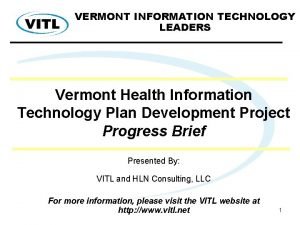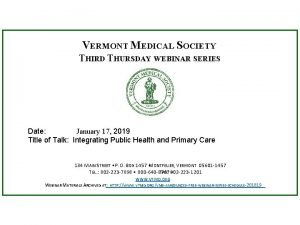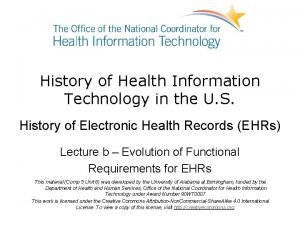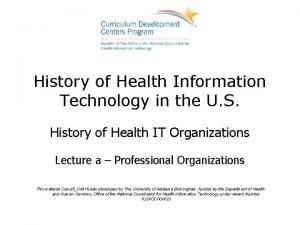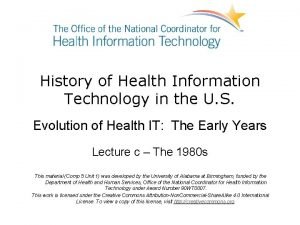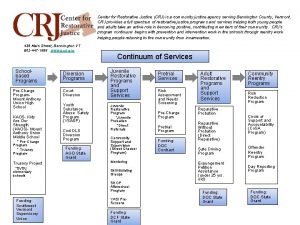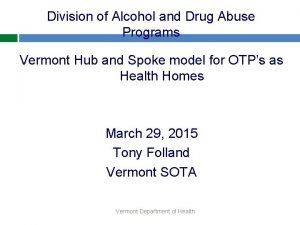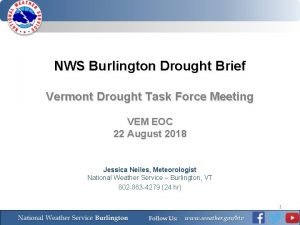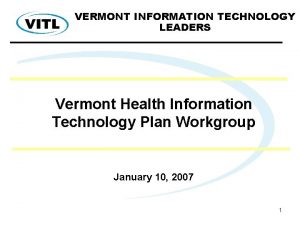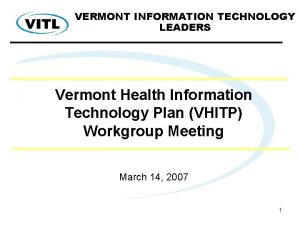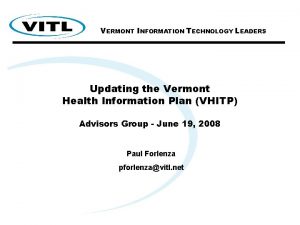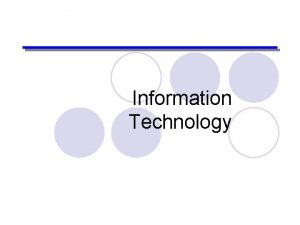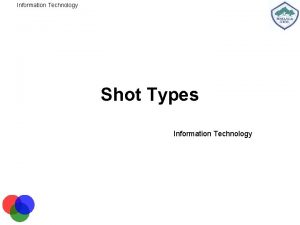VERMONT INFORMATION TECHNOLOGY LEADERS Vermont Health Information Technology




















- Slides: 20

VERMONT INFORMATION TECHNOLOGY LEADERS Vermont Health Information Technology Plan Development Project Progress Brief Presented By: VITL and HLN Consulting, LLC For more information, please visit the VITL website at http: //www. vitl. net 1

Agenda • Report on Project Kickoff Meeting • General Strategy/Organization of Plan Development • Preliminary Plan • Top Level Concepts Proposed by Working Group • Key Issues/Challenges in Developing the Plan • Next Steps and Important Dates 2

Project Kickoff Meeting • Meeting held November 1, 2006 • Reviewed the Vermont Health Information Technology Plan legislation • Met the HLN team • Discussed deliverables, deadlines, schedule, and progress to-date • Proposed a development strategy and organization • Reviewed proposed plan outlines • Reviewed a matrix of features of other state plans 3

Project Kickoff Meeting (continued) • Received brief project updates from: – Hans Kastensmith – statewide assessment – Art Limacher – Blueprint CCIS – Craig Stevens – RTI initiatives – Judy Higgins – OVHA/GCR • Proposed and discussed a set of key challenges for plan development • Proposed and discussed a set of preliminary principles, goals, and barriers, as well as other potential “top level” concepts. 4

General Plan Strategy and Organization • Ad hoc working group (open to all) will provide advisory role • VITL Executive Committee will also participate • VITL Board will act as steering committee • Four VITL committees will contribute and advise • Interim and final documents on project website 5

Project Website 6

HLN Contract Summary • • Strategic direction and leadership Project management Content production HLN is ultimately responsible for the production of the plan and to ensure that key stakeholders who do not participate in the work group are brought to the table via interviews. 7

Parallel Activities • Craig Stevens / RTI • Hans Kastensmith / Statewide assessment • Lessons learned and barriers in: – VITL pilot – CCIS – Medicaid GCR • NECLA • VDH Immunization Registry • PHIN efforts 8

Preliminary Plan • Opportunity to be provocative, present a compelling vision • Present what is going to be in the final plan • Clarify and set expectations on scope • Convey the progress that VITL has made to date • Not a draft plan, but “the plan for the plan” 9

Preliminary Plan (continued) • 10 -15 pages seems right: – Background – Progress to date – A preview of what is going to be in the plan: • Discussion of Goals, Principles, Barriers, Vision • Audiences, Stakeholders (i. e. , “Who the plan affects”) • Detailed outline and plan features 10

Top Level Concepts: Principles • HIE as a driver for improved HIT and EHI • Standards-based HIE, while not dictating all standards related to HIT (for example, more flexible on vocabulary, more strict on interchange standards) • Practical now, ideal later • To be clear on issues that stakeholders cannot agree on, that are currently in flux at the state or national level, and issues that are out of scope for this plan. • That the plan evolves and a structure exists to keep it updated (avoid “rip and tear”) 11

Top Level Concepts: Goals • Reduction of duplicate services • Improved patient safety • More comprehensive and proactive chronic care • Patient and caregiver control over medical information • Improved patient outcomes • Measurable outcomes 12

Top Level Concepts: Barriers • Lack of network access; Communications and network infrastructure especially to small and rural practices • Privacy and security issues • Capitalization, especially for small practices and hospitals • Lack of a communications plan. • Data quality 13

Top Level Concepts: Others • Not discussed thoroughly: – Vision (use cases) – Audiences (i. e. , Legislators, Consumers, Providers, Doctor in small practice considering investing in an EMR) – Value 14

Key Issues/Challenges • Scope of the plan: HIT broadly speaking? Just HIE? • Is it a plan for VT or a plan for VITL? • How can VITL’s role be effectively communicated? • Can a compelling enough vision be articulated that resonates with a broad enough constituency, including consumers? 15

Key Issues/Challenges (continued) • Can we strike a balance between too much and too little detail? • Should the plan be structured around a key set of recommendations (like TX)? • How strongly should the consumer/patient control perspective be present in the plan? • Can the plan be sensitive to the varying perspectives of the state’s role? 16

Project Scope Diagram 17

Project Scope Diagram (continued) • Health Information Technology (HIT) is the infrastructure and data that helps to automate health care processes. Health Information Exchange (HIE) is the part of HIT that enables interoperability between systems and organizations. Together, through proper investment, they provide opportunities to improve the overall healthcare system. • While VITL is most concerned with HIE, Vermont’s Health Information Technology Plan will offer strategies for stakeholders to assess the compatibility of their own HIT investment decisions with the state’s direction. Standards ensure that investments are made consistently. 18

Next Steps • HLN will feed the lists of top-level concepts back to the working group, via the website, combined with some additional concepts gleaned from other state plans. • The working group is in the process of reviewing a set of features documented from other state and national plans. Members are identifying “top ten” and “bottom ten” features from the perspective of their organizations. • A follow-up meeting on November 8 will allow for further discussion on the concepts and challenges, a review of “top” and “bottom” features, and a more detailed discussion of possible plan outlines that 19 have been proposed.

Important Dates • • • Preliminary plan contents (11/8) Assignments (11/8 – 11/15) Draft (12/13) Review period / Approval process (to 12/31) Submission 20
 Hans kastensmith
Hans kastensmith Vermont department of health
Vermont department of health Vermont blueprint for health
Vermont blueprint for health Future health leaders
Future health leaders Difference between health promotion and health education
Difference between health promotion and health education History of health information technology
History of health information technology Health information technology history
Health information technology history History and evolution of health information technology
History and evolution of health information technology Vermont association of criminal defense lawyers
Vermont association of criminal defense lawyers Rule 4500 vermont
Rule 4500 vermont Augusta is the capital of what state
Augusta is the capital of what state Crj bennington vt
Crj bennington vt Pine marten vermont
Pine marten vermont Romeo and juliet law vermont
Romeo and juliet law vermont Dystocia
Dystocia Child development clinic vermont
Child development clinic vermont Medical examiner vs coroner
Medical examiner vs coroner Vermont doh
Vermont doh Hope greenberg
Hope greenberg Vermont sheep and goat
Vermont sheep and goat Vermont drought monitor
Vermont drought monitor
